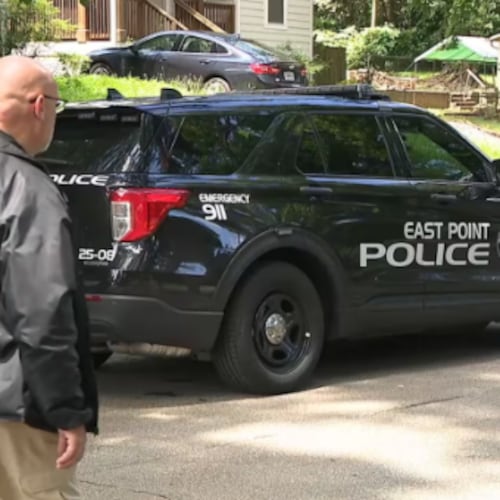BRUNSWICK - On the eve of opening statements in one of the highest-profile murder trials in Georgia history, the judge presiding over the case involving Ahmaud Arbery’s killing dealt a series of blows to the defense.
Judge Timothy Walmsley granted the prosecution’s motion to exclude evidence of “minute” levels of THC discovered in Arbery’s system after his death from being introduced at trial. Walmsley also ruled that graphic body camera footage depicting the 25-year-old dying on the ground from three shotgun blasts would be shown to jurors.
Defense attorneys sought to exclude the video of a blood-soaked Arbery lying in the street after being shot by Travis McMichael during a struggle over the gun.
“There is a part of that video that’s very inflammatory,” McMichael’s attorney, Jason Sheffield, said of the police footage.
Lead prosecutor Linda Dunikoski argued the video is important because it shows what happened in the moments after the shooting, including where the defendants were in relation to Arbery and what they told police when officers arrived on scene.
Credit: Body camera photos
Credit: Body camera photos
When a Glynn County police officer rolled the dying Arbery onto his back, the extent of his injuries was apparent, Dunikoski said, noting that an expert would testify at trial that the first shotgun blast alone was enough to kill him.
McMichael, his father Greg, and their neighbor, William “Roddie” Bryan, all of whom are white, are standing trial for murder and other charges in the February 2020 death of Arbery. He was Black.
The defendants contend they were trying to make a citizen’s arrest because they suspected Arbery of entering a home under construction in their Satilla Shores neighborhood following a string of break-ins.
Walmsley ultimately agreed to keep the footage as evidence, calling the officer’s video “a very real depiction of a scene that may be shocking to some.”
“There’s a lot of emotion associated with this case,” he said Thursday afternoon.
Walmsley also granted a motion from the state seeking to exclude the defense from calling in two use of force experts to testify about Travis McMichael’s training during his time in the U.S. Coast Guard.
What remains to be seen, however, is whether the judge will allow defense attorneys to bring up Arbery’s probation status once the jury is sworn in Friday. Defense attorneys have asked Walmsley to let jurors know Arbery was on probation when he was killed, arguing such evidence could explain why he ran away from Bryan and the McMichaels that afternoon.
Frank Hogue, who represents Greg McMichael, said Arbery was running “at a sprint, not a Sunday jog.”
“A reasonable alternative explanation could be, ‘Well, Mr. Arbery is running because he’s on probation and has been spotted, at the least trespassing,” Hogue said, “at the worst, back in the house he’d been in four previous times where burglaries had occurred.’”
Arbery, who was unarmed, had no stolen items on him when he was killed.
It’s also unclear if the judge will allow the prosecution to introduce as evidence photos and videos of the old Georgia state flag license plate that was on the front of Travis McMichael’s pickup truck the day Arbery was killed.
Georgia’s prior flag, flown from 1956 through 2001, prominently featured the Confederate battle emblem, and Travis McMichael’s attorneys raised concerns that allowing such evidence could open the door for prosecutors to depict their client as racist.
Prosecutors have argued he attached the flag license plate to his newly purchased truck “for all the world to see.”
“He wanted people to see him driving around with this on the front of his truck,” Dunikoski said. “This is something he put on his car to advertise to the world as he drove around Brunswick.”
Walmsley is expected to rule on both the Confederate flag issue and Arbery’s probation status before opening statements begin.
Tensions are high in this coastal Georgia county of 85,000 over Arbery’s killing, which many consider to be racially motivated.
On Wednesday, Walmsley seated a jury of 11 white people and one Black man over the objections of prosecutors. They contended that the defense exercised their strikes against eight Black jurors because of their race. All told, the defense struck 11 of the 12 qualified Black people in the jury pool.
Arbery’s aunt, Thea Brooks, said Thursday morning she was disappointed in the racial makeup of the empaneled jury, but optimistic they would reach guilty verdicts in her nephew’s death.
She said it was yet another challenge her family faces in the ongoing saga.
“But I feel like the people on the jury will do the best thing for our community,” she said.
As the judge weighed various motions inside the courtroom, spirits swelled outside on the courthouse lawn.
Arbery’s family gathered in the grass, joined by the Transformative Justice Coalition, Black Voters Matter and the Georgia Chapter of the National Organization of Women. Demonstrators by the dozen gathered in a tight circle before marching across the parking lot into Brunswick’s downtown area.
Credit: Asia Simone Burns / asia.burns@ajc.com
Credit: Asia Simone Burns / asia.burns@ajc.com
”Everybody knows they tried to get us kicked off the courthouse grounds,” said Barbara Arnwine, the Transformative Justice Coalition co-leader, as demonstrators marched single file down the yellow stripe in the middle of Norwich Street. “But we got something to say to them. Because we shall not, we shall not be moved!”
The protestors sang and chanted as they marched, with Arbery’s father, Marcus, leading the gatherers down the street.
When the group turned the corner onto Albany Street, they approached the Brunswick African American Cultural Center, the walls of which bear a mural of his son’s face. The group stopped outside the building and, on their knees, prayed in the grass. After the prayer, Marcus Arbery stood and gazed up at his son’s face.
The Latest
Featured




